Section 11 of 15
Section 10: School Buses
You should be thoroughly familiar with California and your local school district laws and regulations.
A CLP holder with a “P” and/or an “S” endorsement is prohibited from operating a CMV with passengers, other than federal/state auditors and inspectors, test examiners, other trainees, and the accompanying CDL holder (CFR, Title 49 §383.25).
Note As of July 1, 2018, it is required that a passenger in a bus equipped with seat belts to be properly restrained by a safety belt. Parents, legal guardians, or chartering parties are prohibited from transporting on a bus that is equipped with safety belts, or permitting to be transported on a bus that is equipped with safety belts, a child, ward, or passenger who is under 8 years of age and under 4 feet 9 inches in height, but under 16 years old, unless they are properly restrained by a safety belt.
10.1 – Danger Zones and Use of Mirrors
10.1.1 – Danger Zones
The danger zone is the area on all sides of the bus where children are in the most danger of being hit, either by another vehicle or their own bus. The danger zones may extend as much as 30 feet from the front bumper (with the first 12 feet being the most dangerous), 12 feet from the left and right sides, and 12 feet behind the rear bumper of the school bus. In addition, the area to the left of the bus is always considered dangerous because of passing cars. Figure 10.1 illustrates these danger zones.
10.1.2 – Correct Mirror Adjustment
Proper adjustment and use of all mirrors is vital to the safe operation of the school bus in order to observe the danger zone around the bus and look for students, traffic, and other objects in this area. You should always check each mirror before operating the school bus to obtain maximum viewing area. If necessary, have the mirrors adjusted.
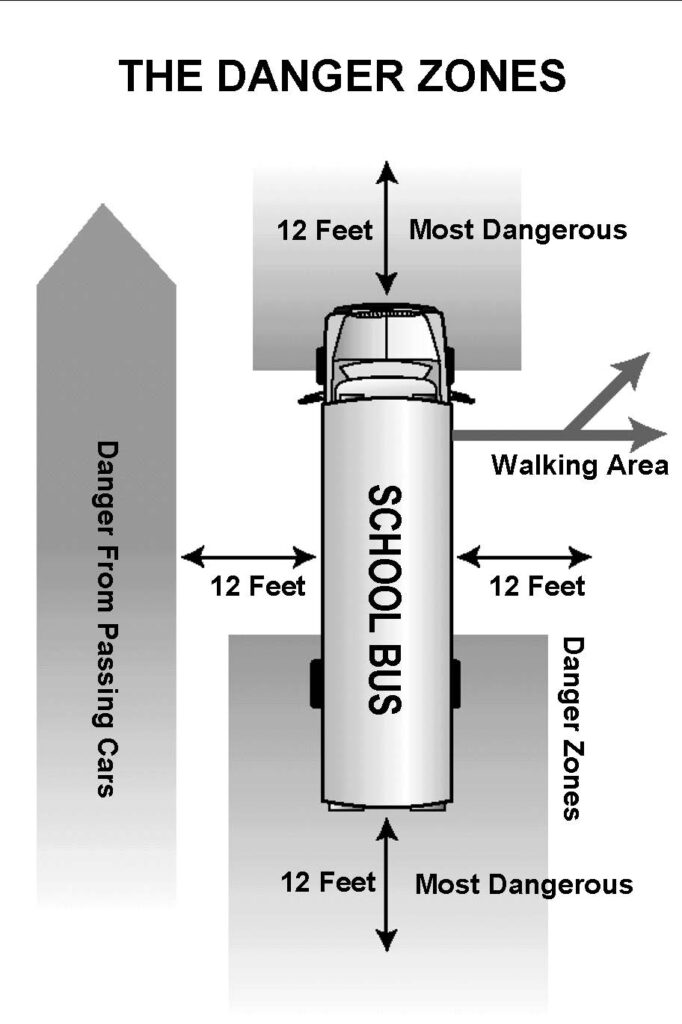
Figure 10.1
10.1.3 – Outside Left and Right Side Flat Mirrors
These mirrors are mounted at the left and right front corners of the bus at the side or front of the windshield. They are used to monitor traffic, check clearances, and check for students on the sides and to the rear of the bus. There is a blind spot immediately below and in front of each mirror and directly in back of the rear bumper. The blind spot behind the bus extends 50 to 150 feet and could extend up to 400 feet depending on the length and width of the bus.
Ensure that the mirrors are properly adjusted so you can see:
- 200 feet or 4 bus lengths behind the bus.
- Along the sides of the bus.
- The rear tires touching the ground.
Figure 10.2 shows how both the outside left and right side flat mirrors should be adjusted.
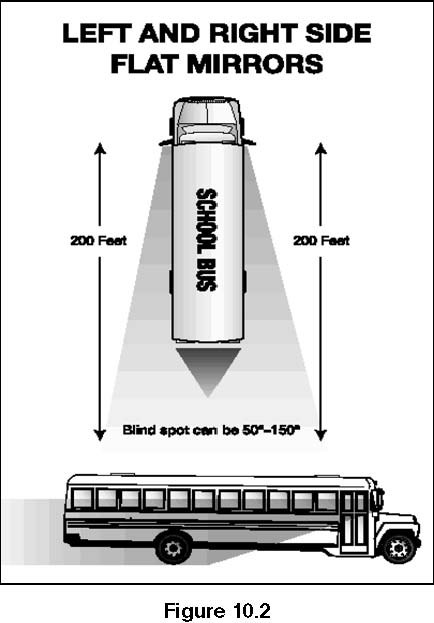
10.1.4 – Outside Left and Right Side Convex Mirrors
The convex mirrors are located below the outside flat mirrors. They are used to monitor the left and right sides at a wide angle. They provide a view of traffic, clearances, and students at the side of the bus. These mirrors present a view of people and objects that does not accurately reflect their size and distance from the bus.
You should position these mirrors to see:
- The entire side of the bus up to the mirror mounts.
- The front of the rear tires touching the ground.
- At least 1 traffic lane on either side of the bus.
Figure 10.3 shows how both the outside left and right side convex mirrors should be adjusted.
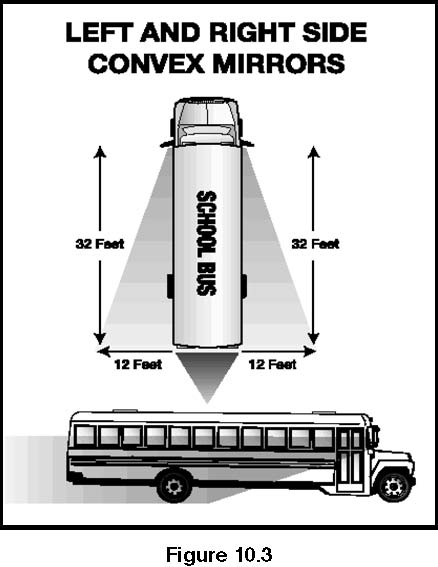
10.1.5 – Outside Left and Right Side Crossview Mirrors
These mirrors are mounted on both the left and right front corners of the bus. They are used to see the front bumper “danger zone” area directly in front of the bus that is not visible by direct vision, and the “danger zone” area to the left and right side of the bus, including the service door and front wheel area. The mirror presents a view of people and objects that does not accurately reflect their size and distance from the bus. The driver must ensure that these mirrors are properly adjusted. Every school bus shall be equipped with a crossview mirror mounted on the front exterior of the bus to provide the seated driver with a clear view of the area directly in front of the bus (CCR, Title 13 §1258).
Ensure that the mirrors are properly adjusted so you can see:
- The entire area in front of the bus from the front bumper at ground level to a point where direct vision is possible. Direct and mirror view vision should overlap.
- The right and left front tires touching the ground.
- The area from the front of the bus to the service door.
- These mirrors, along with the convex and flat mirrors, should be viewed in a logical sequence to ensure that a child or object is not in any of the danger zones.
Figure 10.4 illustrates how the left and right side crossview mirrors should be adjusted.
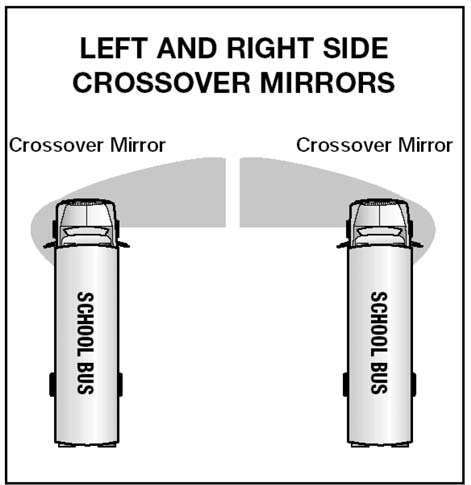
Figure 10.4
10.1.6 – Overhead Inside Rearview Mirror
This mirror is mounted directly above the windshield on the driver’s side area of the bus. This mirror is used to monitor passenger activity inside the bus. It may provide limited visibility directly behind the bus if the bus is equipped with a glass-bottomed rear emergency door. There is a blind spot area directly behind the driver’s seat, as well as a large blind spot area that begins at the rear bumper and could extend up to 400 feet or more behind the bus. You must use the exterior side mirrors to monitor traffic that approaches and enters this area.
You should position the mirror to see:
- The top of the rear window in the top of the mirror.
- All of the students, including the heads of the students right behind you.
10.2 – Loading and Unloading
More students are killed while getting on or off a school bus each year than are killed as passengers inside of a school bus. As a result, knowing what to do before, during, and after loading or unloading students is critical. This section will give you specific procedures to help you avoid unsafe conditions that could result in injuries and fatalities during and after loading and unloading students.
The information in this section is intended to provide a broad overview, but is not a definitive set of actions. It is imperative that you learn and obey California’s laws and regulations governing loading/unloading operations.
10.2.1 – Approaching the Stop
Each school district establishes official routes and school bus stops. All stops should be approved by the school district prior to making the stop. You should never change the location of a bus stop without written approval from the appropriate school district official.
You must use extreme caution when approaching a school bus stop. You are in a very demanding situation when entering these areas. It is critical that you understand and follow all state and local laws and regulations regarding approaching a school bus stop. This would involve the proper use of mirrors, alternating flashing lights, and, when equipped, the moveable stop signal arm, and crossing control arm.
When approaching the stop, you should:
- Approach cautiously at a slow rate of speed.
- Look for pedestrians, traffic, or other objects before, during, and after coming to a stop.
- Continuously check all mirrors.
- If the school bus is so equipped, activate alternating flashing amber warning lights at least 200 feet or approximately 5–10 seconds before the school bus stop or in accordance with state law.
- Turn on the right turn signal indicator about 100–300 feet or approximately 3–5 seconds before pulling over.
- Continuously check mirrors to monitor the danger zones for students, traffic, and other objects.
- Move as far as possible to the right on the traveled portion of the roadway.
When stopping, you should:
- Bring the school bus to a full stop with the front bumper at least 10 feet away from students at the designated stop. This forces the students to walk to the bus so you have a better view of their movements.
- Place the transmission in Park or, if there is no Park shift point, in Neutral, and set the parking brake at each stop.
- Activate the alternating red lights when traffic is a safe distance from the school bus and ensure the stop arm is extended.
- Make a final check to see that all traffic has stopped before completely opening the door and signaling students to approach.
10.2.2 – Loading Procedures
Perform a safe stop as described in Section 10.
- Students should wait in a designated location for the school bus, facing the bus as it approaches.
- Students should board the bus only when signaled by the driver.
- Monitor all mirrors continuously.
- Count the number of students at the bus stop and be sure all board the bus. If possible, know the names of students at each stop. If there is a student missing, ask the other students where the student is.
- Have the students board the school bus slowly, in single file, and use the handrail. The dome light should be on while loading in the dark.
- Wait until students are seated and facing forward before moving the bus.
- Check all mirrors. Make certain no one is running to catch the bus.
- If you cannot account for a student, secure the bus, take the key, and check around and underneath the bus.
- When all students are accounted for, prepare to leave by:
— Closing the door.
— Engaging the transmission.
— Releasing the parking brake.
— Turning off the alternating flashing red lights.
— Turning on the left turn signal.
— Checking all mirrors again.
— Allowing congested traffic to disperse. - When it is safe, move the bus, enter the traffic flow, and continue the route.
The loading procedure is essentially the same wherever you load students, but there are slight differences. When students are loading at the school campus, you should:
- Turn off the ignition switch.
- Remove the key if leaving the driver’s compartment.
- Position yourself to supervise loading.
10.2.3 – Unloading Procedures on the Route
Perform a safe stop at designated unloading areas as described in Section 10.
- Have the students remain seated until told to exit.
- Check all mirrors.
- Count the number of students while unloading to confirm the location of all students before pulling away from the stop.
- Tell students to exit the bus and walk at least 10 feet away from the side of the bus to a position where the driver can plainly see all students.
- Check all mirrors again. Make sure no students are around or returning to the bus.
- If you cannot account for a student, secure the bus, take the key, and check around and underneath the bus.
- When all students are accounted for, prepare to leave by:
— Closing the door.
— Engaging the transmission.
— Releasing the parking brake.
— Turning off the alternating flashing red lights.
— Turning on the left turn signal.
— Checking all mirrors again.
— Allowing congested traffic to disperse. - When it is safe, move the bus, enter the traffic flow, and continue the route.
Note If you miss a student’s unloading stop, do not back up. Be sure to follow local procedures.
Additional Procedures for Students who Must Cross the Roadway
When a school bus is stopped on a highway or private road for the purpose of loading or unloading pupils, at a location where traffic is not controlled by a traffic officer or official traffic control signal, the school bus driver shall do all of the following:
- Escort all students in prekindergarten, kindergarten, or any grades 1 through eighth, who need to cross the highway or private road where the school bus stopped. The driver shall use an approved, hand-held “STOP” sign while escorting all students.
- Require all students who cross the highway or private road where the school bus stopped to walk in front of the bus as they cross.
- Ensure that all students who cross the highway or private road where the school bus stopped have crossed safely, and that all other students and pedestrians are at a safe distance from the school bus before setting the school bus in motion.
Note The school bus driver should enforce any state or local regulations or recommendations concerning student actions outside the school bus.
10.2.4 – Unloading Procedures at School
State and local laws and regulations regarding unloading students at schools, particularly in situations where activities take place in the school parking lot or other location off the traveled roadway, are often different than unloading along the school bus route. It is important that the school bus driver understands and obeys state and local laws and regulations. The following procedures are meant to be general guidelines.
When unloading at the school, you should follow these procedures:
- Perform a safe stop at designated unloading areas as described in Section 10.
- Secure the bus by:
— Turning off the ignition switch.
— Removing the key if leaving driver’s compartment. - Have the students remain seated until told to exit.
- Position yourself to supervise unloading.
- Escort all students in prekindergarten, kindergarten, or any grades 1 through 8, inclusive, who need to cross the highway or private road where the school bus stopped. The driver shall use an approved, hand-held “STOP” sign while escorting all students.
- Have the students exit in orderly fashion.
- Observe the students as they step from the bus to see that they all move promptly away from the unloading area.
- Walk through the bus to check for hiding/sleeping students and items left by students.
- Check all mirrors. Make certain no students are returning to the bus.
- If the bus is secure and you cannot account for a student outside the bus, check around and underneath the bus.
- When all students are accounted for, prepare to leave by:
— Closing the door.
— Fastening the safety belt.
— Starting the engine.
— Engaging the transmission.
— Releasing the parking brake.
— Turning off the alternating flashing red lights.
— Turning on the left turn signal.
— Checking all mirrors again.
— Allowing congested traffic to disperse. - When it is safe to do so, pull away from the unloading area.
10.2.5 – Special Dangers of Loading and Unloading
Dropped or Forgotten Objects. Always focus on students as they approach the bus and watch for any who disappear from sight. Students may drop an object near the bus during loading and unloading. Stopping to pick up the object or returning to pick up the object may cause the student to disappear from the driver’s sight at a very dangerous moment. Students should be told to leave any dropped object and move to a point of safety out of the danger zones and attempt to get the driver’s attention to retrieve the object.
Handrail Hang-Ups. Students have been injured or killed when clothing, accessories, or even parts of their body are caught in the handrail or door as they exited the bus. You should closely observe all students exiting the bus to confirm that they are in a safe location prior to moving the bus.
10.2.6 – Post-Trip Inspection
When your route or school activity trip is finished, you should conduct a post-trip inspection of the bus.
You should walk through the bus and around the bus to look for the following:
- Articles left on the bus.
- Sleeping students.
- Open windows and doors.
- Mechanical/operational problems with the bus, with special attention to items that are unique to school buses–mirror systems, flashing warning lamps, and stop signal arms.
- Damage or vandalism.
Any problems or special situations should be reported immediately to your supervisor or school authorities.
10.3 – Emergency Exit and Evacuation
An emergency situation can happen to anyone, anytime, anywhere. It could be an accident, a stalled school bus on a railroad-highway crossing or in a high-speed intersection, an electrical fire in the engine compartment, or medical emergency to a student on the school bus, etc. Knowing what to do in an emergency–before, during, and after an evacuation–can mean the difference between life and death.
10.3.1 – Planning for Emergencies
Determine the Need to Evacuate the Bus. The first and most important consideration is for you to recognize the hazard. If time permits, school bus drivers should contact their dispatcher to explain the situation before making a decision to evacuate the school bus.
As a general rule, student safety and control is best maintained by keeping students on the bus during an emergency and/or impending crisis situation, if it does not expose them to unnecessary risk or injury. Remember, the decision to evacuate the bus must be a timely one.
A decision to evacuate should include consideration of the following conditions:
- Is there a fire or danger of fire?
- Is there a smell of raw or leaking fuel?
- Is there a chance the bus could be hit by other vehicles?
- Is the bus in the path of a sighted tornado or rising waters?
- Are there downed power lines?
- Would removing students expose them to speeding traffic, severe weather, or a dangerous environment such as downed power lines?
- Would moving students complicate injuries such as neck and back injuries and fractures?
- Is there a hazardous spill involved? Sometimes, it may be safer to remain on the bus and not come in contact with the material.
Mandatory Evacuations. The driver must evacuate the bus when:
- The bus is on fire or there is a threat of a fire.
- The bus is stalled on or adjacent to a railroad-highway crossing.
- The position of the bus may change and increase the danger.
- There is an imminent danger of an accident.
- There is a need to quickly evacuate because of a HazMat spill.
10.3.2 – Evacuation Procedures
Be Prepared and Plan Ahead. When possible, assign 2 older, responsible student assistants to each emergency exit. Teach them how to assist the other students off the bus. Assign another student assistant to lead the students to a “safe place” after evacuation. However, you must recognize there may not be older, responsible students on the bus at the time of the emergency. Therefore, emergency evacuation procedures must be explained to all students. This includes knowing how to operate the various emergency exits and the importance of listening to and following all instructions given by you.
Some tips to determine a safe place:
- A safe place will be at least 100 feet off the road in the direction of oncoming traffic. This will keep the students from being hit by debris if another vehicle collides with the bus.
- Lead students upwind (into the wind) of the bus if fire is present.
- Lead students as far away from railroad tracks as possible and in the direction of any oncoming train.
- Lead students upwind of the bus at least 300 feet if there is a risk from spilled HazMat.
- If the bus is in the direct path of a sighted tornado and evacuation is ordered, escort students to a nearby ditch or culvert if shelter in a building is not readily available, and direct them to lie face down, hands covering their head. They should be far enough away so the bus cannot topple on them. Avoid areas that are subject to flash floods.
General Procedures. Determine if evacuation is in the best interest of safety.
- Determine the best type of evacuation:
— Front, rear, side door, or some combination of doors evacuation.
— Roof or window evacuation. - Secure the bus by:
— Placing transmission in Park or, if there is no shift point, in Neutral.
— Setting the parking brakes.
— Shutting off the engine.
— Removing the ignition key.
— Activating the hazard-warning lights.
— If time allows, notifying your dispatch office of the evacuation location, conditions, and type of assistance needed. - Dangle the radio microphone or telephone out of the driver’s window and take your cell phone for later use, if operable.
- If there is no radio or cell phone or they are inoperable, dispatch a passing motorist or area resident to call for help. As a last resort, dispatch 2 older, responsible students to go for help.
- Order the evacuation.
- Evacuate the students from the bus.
— Do not move a student you believe may have suffered a neck or spinal injury unless his or her life is in immediate danger.
— Special procedures must be used to move neck spinal injury victims to prevent further injury. - Direct a student assistant to lead students to the nearest safe place.
- Walk through the bus to ensure no students remain on the bus. Retrieve emergency equipment.
- Join waiting students. Account for all students and check for their safety.
- Protect the scene. Set out emergency warning devices as necessary and appropriate.
- Prepare information for emergency responders.
10.4 – Railroad-Highway Crossings
10.4.1 – Types of Crossings
Passive Crossings. This type of crossing does not have any type of traffic control device. You must stop at these crossings and follow proper procedures. However, the decision to proceed rests entirely in your hands. Passive crossings require you to recognize the crossing, search for any train(s) using the tracks, and decide if there is sufficient clear space to cross safely. Passive crossings have yellow circular advance warning signs, pavement markings, and crossbucks to assist you in recognizing a crossing.
Active Crossings. This type of crossing has a traffic control device installed at the crossing to regulate traffic at the crossing. These active devices include flashing red lights with or without bells, and flashing red lights with bells and gates.
10.4.2 – Warning Signs and Devices
Advance Warning Signs. This round, black-on-yellow warning sign is placed ahead of a public railroad-highway crossing. The advance warning sign tells you to slow down, look and listen for the train, and be prepared to stop at the tracks if a train is coming. See Figure 10.5.
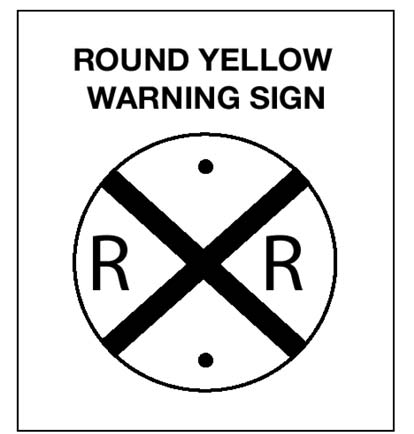
Figure 10.5
Pavement Markings. Pavement markings mean the same as the advance warning sign. They consist of an “X” with the letters “RR” and a no-passing marking on 2-lane roads.
There is also a no passing zone sign on 2-lane roads. There may be a white stop line painted on the pavement before the railroad tracks. The front of the school bus must remain behind this line while stopped at the crossing. See Figure 10.6.
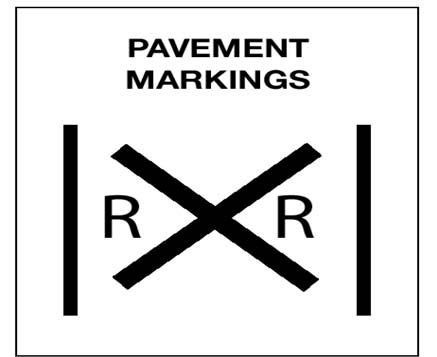
Figure 10.6
Crossbuck Signs. This sign marks the crossing. It requires you to yield the right-of-way to the train. If there is no white line painted on the pavement, you must stop the bus before the crossbuck sign. When the road crosses over more than one set of tracks, a sign below the crossbuck indicates the number of tracks. See Figure 10.7.
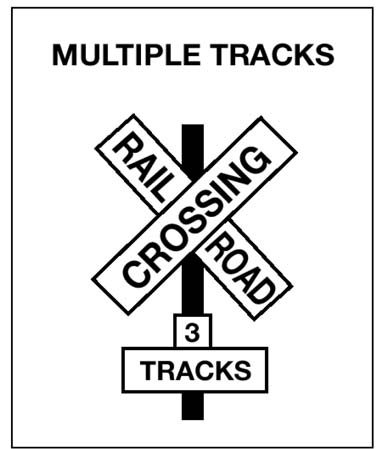
Figure 10.7
Flashing Red Light Signals. At many railroad-highway crossings, the crossbuck sign has flashing red lights and bells. When the lights begin to flash, you must stop! A train is approaching. You are required to yield the right-of-way to the train. If there is more than 1 track, make sure all tracks are clear before crossing. See Figure 10.8.
Gates. Many railroad-highway crossings have gates with flashing red lights and bells. Stop when the lights begin to flash and before the gate lowers across the road lane. Remain stopped until the gates go up and the lights have stopped flashing. Proceed when it is safe. If the gate stays down after the train passes, do not drive around the gate. Instead, call your dispatcher. See Figure 10.8.
10.4.3 – Recommended Procedures
Each state has laws and regulations governing how school buses must operate at railroad-highway crossings. It is important for you to understand and obey these state laws and regulations. In general, school buses must stop at all crossings, and drivers must ensure it is safe before proceeding across the tracks. The specific procedures required in each state vary.
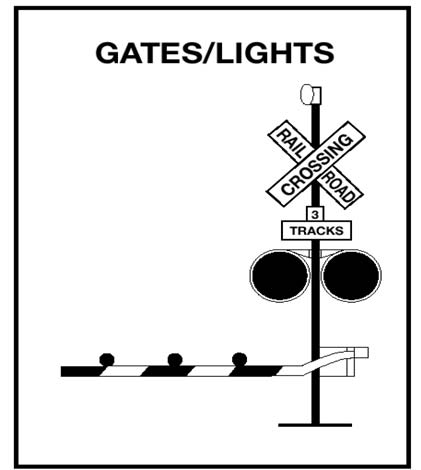
Figure 10.8
A school bus is one of the safest vehicles on the highway. However, a school bus does not have the slightest edge when involved in an accident with a train. Because of a train’s size and weight it cannot stop quickly. An emergency escape route does not exist for a train. You can prevent school bus/train accidents by following these recommended procedures.
- Approaching the Crossing:
— Slow down, including shifting to a lower gear in a manual transmission bus, and test your brakes.
— Activate hazard lights approximately 200 feet before the crossing. Make sure your intentions are known.
— Scan your surroundings and check for traffic behind you.
— Stay to the right of the roadway if possible.
— Choose an escape route in the event of a brake failure or problems behind you. - At the Crossing:
— Stop no closer than 15 feet and no farther than 50 feet from the nearest rail, where you have the best view of the tracks.
— Place the transmission in Park or, if there is no Park shift point, in Neutral and press down on the service brake or set the parking brakes.
— Turn off all radios and noisy equipment, and silence the passengers.
— Open the service door and driver’s window. Look and listen for an approaching train. - Crossing the Track:
— Check the crossing signals again before proceeding.
— At a multiple-track crossing, stop only before the first set of tracks. When you are sure no train is approaching on any track, proceed across all of the tracks until you have completely cleared them.
— Cross the tracks in a low gear. Do not change gears while crossing.
— If the gate comes down after you have started across, drive through it, even if it means you will break the gate.
10.4.4 – Special Situations
Bus Stalls or Is Trapped on the Tracks. If your bus stalls or is trapped on the tracks, get everyone out and off the tracks immediately. Move everyone far from the bus at an angle, which is both away from the tracks and toward the train.
Police Officer at the Crossing. If a police officer is at the crossing, obey directions. If there is no police officer, and you believe the signal is malfunctioning, call your dispatcher to report the situation and ask for instructions on how to proceed.
Obstructed View of Tracks. Plan your route so it provides maximum sight distance at railroad-highway crossings. Do not attempt to cross the tracks unless you can see far enough down the track to know for certain that no trains are approaching. Passive crossings are those that do not have any type of traffic control device. Be especially careful at “passive” crossings. Even if there are active railroad signals that indicate the tracks are clear, you must look and listen to be sure it is safe to proceed.
Containment or Storage Areas. If it will not fit, do not commit! Know the length of your bus and size of the containment area at railroad-highway crossings on the school bus route, as well as any crossing you encounter in the course of a school activity trip. When approaching a crossing with a signal or stop sign on the opposite side, pay attention to the amount of room there. Be certain the bus has enough containment or storage area to completely clear the railroad tracks on the other side if there is a need to stop. As a general rule, add 15 feet to the length of the school bus to determine an acceptable amount of containment or storage area.
10.5 – Student Management
10.5.1 – Do Not Deal with On-Bus Problems When Loading and Unloading
In order to get students to and from school safely and on time, you need to be able to concentrate on the driving task.
Loading and unloading requires all your concentration. Do not take your eyes off what is happening outside the bus.
If there is a behavior problem on the bus, wait until the students unloading are safely off the bus and have moved away. If necessary, pull the bus over to handle the problem.
10.5.2 – Handling Serious Problems
Tips on handling serious problems:
- Follow your school’s procedures for discipline or refusal of rights to ride the bus.
- Stop the bus. Park in a safe location off the road, perhaps a parking lot or driveway.
- Secure the bus. Take the ignition key with you if you leave your seat.
- Stand up and speak respectfully to the offender or offenders. Speak in a courteous manner with a firm voice. Remind the offender of the expected behavior. Do not show anger, but do show that you mean business.
- If a change of seating is needed, request that the student move to a seat near you.
- Never put a student off the bus except at school or their designated school bus stop. If you that the offense is serious enough that you cannot safely drive the bus, call a school administrator or the police to come and remove the student.
10.6 – Anti-Lock Braking Systems
10.6.1 – Vehicles Required to Have ABS
The U.S. DOT requires that ABS be on:
- Air brake vehicle, (trucks, buses, trailers, and converter dollies) built on or after March 1, 1998.
- Hydraulic-braked trucks and buses with a GVWR of 10,000 pounds or more, built on or after March 1, 1999.
Many buses built before these dates have been voluntarily equipped with ABS.
Your school bus will have a yellow ABS malfunction lamp on the instrument panel if equipped with ABS.
10.6.2 – How ABS Helps You
When you brake hard on slippery surfaces in a vehicle without ABS, your wheels may lock up. When your steering wheels lock up, you lose steering control. When your other wheels lock up, you may skid or even spin the vehicle.
ABS helps you avoid wheel lock up and maintain control. You may or may not be able to stop faster with ABS, but you should be able to steer around an obstacle while braking, and avoid skids caused by over braking.
10.6.3 – Braking With ABS
When you drive a vehicle with ABS, you should brake as you always have. In other words:
- Use only the braking force necessary to stop safely and stay in control.
- Brake the same way, regardless of whether you have ABS on the bus. However, in emergency braking, do not pump the brakes on a bus with ABS.
- As you slow down, monitor your bus and back off the brakes (if it is safe to do so) to stay in control.
10.6.4 – Braking if ABS Is Not Working
Without ABS, you still have normal brake functions. Drive and brake as you always have.
Vehicles with ABS have yellow malfunction lamps to tell you if something is not working. The yellow ABS malfunction lamp is on the bus instrument panel.
As a system check on newer vehicles, the malfunction lamp comes on at start-up for a bulb check and then goes out quickly. On older systems, the lamp could stay on until you are driving over 5 mph.
If the lamp stays on after the bulb check, or goes on once you are under way, you may have lost ABS control at 1 or more wheels.
Remember, if your ABS malfunctions, you still have regular brakes. Drive normally, but get the system serviced soon.
10.6.5 – Safety Reminders
ABS will not:
- Allow you to drive faster, follow more closely, or drive less carefully.
- Prevent power or turning skids. ABS should prevent brake-induced skids but not those caused by spinning the drive wheels or going too fast in a turn.
- Necessarily shorten stopping distance. ABS will help maintain vehicle control, but not always shorten stopping distance.
- Increase or decrease ultimate stopping power. ABS is an “add-on” to your normal brakes, not a replacement for them.
- Change the way you normally brake. Under normal brake conditions, your vehicle will stop as it always stopped. ABS only comes into play when a wheel would normally have locked up because of over braking.
- Compensate for bad brakes or poor brake maintenance.
Remember:
— The best vehicle safety feature is still a safe driver.
— Drive so you never need to use your ABS.
— If you need it, ABS could help prevent a serious accident.
10.7 – Special Safety Considerations
10.7.1 – Strobe Lights
Some school buses are equipped with roof-mounted, white strobe lights. If your bus is so equipped, the overhead strobe light should be used when you have limited visibility. This means that you cannot easily see around you – in front, behind, or beside the school bus. Your visibility could be only slightly limited or be so bad that you can see nothing at all. Use strobe lights only when visibility is reduced to 500 feet or less due to atmospheric conditions including, but not limited to, fog, rain, snow, smoke, or dust (CVC §25257.7).
10.7.2 – Driving in High Winds
Strong winds affect the handling of the school bus! The side of a school bus acts like a sail on a sailboat. Strong winds can push the school bus sideways. They can even move the school bus off the road or, in extreme conditions, tip it over.
If you are caught in strong winds:
- Keep a strong grip on the steering wheel. Try to anticipate gusts.
- You should slow down to lessen the effect of the wind, or pull off the roadway and wait.
- Contact your dispatcher to get more information on how to proceed.
10.7.3 – Backing
Backing a school bus is strongly discouraged. You should back your bus only when you have no other safe way to move the vehicle. You should never back a school bus when students are outside of the bus. Backing is dangerous and increases your risk of an accident. If you have no choice and you must back your bus, follow these procedures:
- To warn other motorists or pedestrians on a roadway during a backing maneuver, the operator of a school bus may flash hazard lights (CVC §25257.5).
- Post a lookout. The purpose of the lookout is to warn you about obstacles, approaching persons, and other vehicles. The lookout should not give directions on how to back the bus.
- Signal for quiet on the bus.
- Constantly check all mirrors and rear windows.
- Back slowly and smoothly.
- If no lookout is available:
— Set the parking brake.
— Turn off the motor and take the keys with you.
— Walk to the rear of the bus to determine whether the way is clear. - If you must back up at a student pick up point, be sure to pick up students before backing and watch for late comers at all times.
- Be sure that all students are in the bus before backing.
- If you must back up at a student drop off point, be sure to unload students after backing.
10.7.4 – Tail Swing
A school bus can have up to a 3-foot tail swing. You need to check your mirrors before and during any turning movements to monitor the tail swing.
Section 10
Test Your Knowledge
- Define the danger zone. How far does the danger zone extend around the bus?
- What should you be able to see if the outside flat mirrors are adjusted properly? The outside convex mirrors? The crossview mirrors?
- You are loading students along the route. When should you activate your alternating flashing amber warning lights?
- You are unloading students along your route. Where should students walk to after exiting the bus?
- After unloading at school, why should you walk through the bus?
- What position should students be in, in front of the bus, before they cross the roadway?
- Under what conditions must you evacuate the bus?
- How far from the nearest rail should you stop at a railroad-highway crossing?
- What is a passive railroad-highway crossing? Why should you be extra cautious at this type of crossing?
- How should you use your brakes if your vehicle is equipped with ABS?
These questions may be on your test. If you cannot answer them all, reread Section 10.
